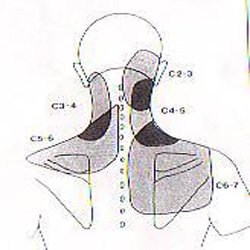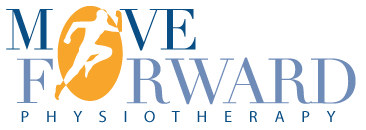Cervical Spine – Non-Specific Neck Pain
Physiotherapy treatment including joint mobilisations and manipulations, specific muscle re-education exercises and soft tissue mobilising techniques have all been found to be useful in the treatment of neck pain from acute through to chronic stages of the condition.
 Research
Research
The Australian Physiotherapy Association has published the “Neck Pain Position Statement” (updated every 2 years), which reviews current research on efficacy of treatment for neck pain. Research published from the University of Queensland has proven that cervical spine mobilisation techniques directly improve pain and mobility levels in both acute and chronic neck pain syndromes.
This diagram, taken from: Aprill C., Dwyer A. & Bogduk N., (1990) Cervical Zygapophyseal Joint Pain Patterns II: A Clinical Evaluation. SPINE 15 (6), demonstrates the patterns of pain referral from the facet joints in the neck. 80% of cervical spine degeneration (discal and joint OA) occurs at the C5/6 level, so the area of pain across the top of the shoulder tends to be the most common patient presentation.
Degeneration of the Mid to Lower Cervical Segments
Degenerative changes at C4/5/6/7 can be accelerated by poor posture (slump sitting with chin poke). Manual physiotherapy treatment and postural correction exercises (strengthening of weak muscles, improving joint mobility of stiffened joints, patient education) are essential to slow down the degenerative process. You will note from the above diagram that upper thoracic spinal pain is often referred pain from the cervical spine rather than a local thoracic spine injury. Sustained poor postures can also lead to upper cervical spine stiffness and headache, and increased thoracic kyphosis with associated stiffening of the thoracic spine.
Presentation
The patient may present with aching within the area of referral for the affected facet joint(s), restricted neck mobility (particularly with rotation, such as difficulty reversing in the car), and sharp pain with end range movement.
Treatment
Joint mobilisations and manipulations, muscle stretches, muscle re-education (strengthening) exercises, postural exercises, thoracic mobility, neural mobilising techniques, and patient education are all important components of physiotherapy treatment for non-specific neck pain. Joints that look degenerative on x-ray do not necessarily have to cause pain. If the joints are mobile and the muscles are strong and flexible, then the patient can expect to have excellent pain free movement and function. It is important to “move it or lose it”.

